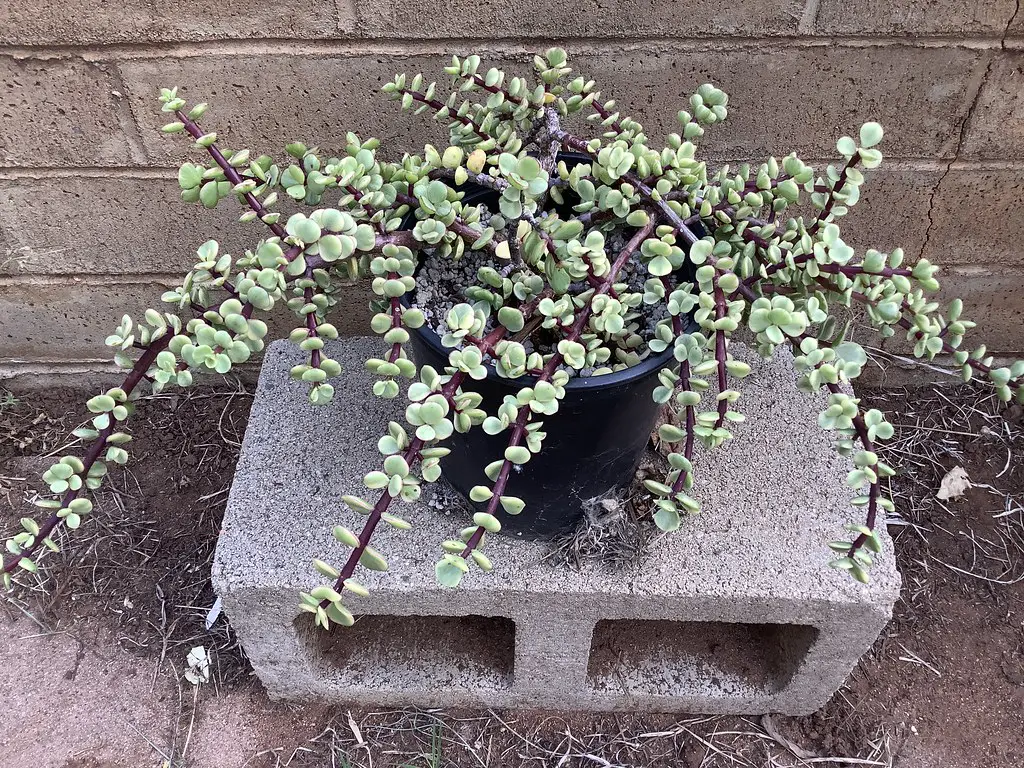Elephant Bush, also known as Elephant Food or Portulacaria afra, is a popular and resilient succulent native to South Africa. This attractive plant gets its common name from its association with elephants that feed on its leaves in the wild. But it’s not just for elephants; people also cultivate Elephant Bush for its ornamental appeal, drought tolerance, and easy care.
The plant’s thick, fleshy leaves, combined with its woody stem, provide a unique appearance that’s both robust and elegant. Available in both green and variegated forms, Elephant Bush can be used in various landscape and indoor designs, offering versatility and a touch of nature’s beauty.
Not only aesthetically pleasing, but Elephant Bush also plays a crucial ecological role in its native environment. It acts as a significant food source for wildlife and helps in soil stabilization. This multifaceted plant has gained popularity worldwide, becoming a staple in gardens and homes, particularly among succulent enthusiasts.
| Attribute | Details |
|---|---|
| Common Names | Elephant Bush, Elephant Food, Spekboom |
| Botanical Name | Portulacaria afra |
| Family | Portulacaceae |
| Plant Type | Succulent |
| Mature Size | 8-15 feet tall in natural habitat, 2-3 feet as potted plant |
| Sun Exposure | Full Sun to Partial Shade |
| Soil Type | Well-draining, sandy soil |
| Hardiness Zones | 9-11 |
| Native Area | South Africa |
Elephant Bush Care
Elephant Bush is known for its low-maintenance care requirements, making it an ideal plant for both beginners and experienced gardeners. It thrives in sunny spots and doesn’t require frequent watering or fertilizing, thanks to its drought-resistant nature.
The key to healthy Elephant Bush is providing the right balance of light, water, and soil. Too much water or poor soil drainage can lead to root rot, while insufficient light may cause leggy growth. Monitoring these factors and making necessary adjustments will ensure a thriving Elephant Bush.
Light Requirement for Elephant Bush
Elephant Bush prefers bright light and can thrive in full sun to partial shade. If grown indoors, placing it near a sunny window or under a grow light will promote healthy growth. In extremely hot climates, some afternoon shade can prevent leaf scorching.
Soil Requirements for Elephant Bush
Well-draining, sandy soil is ideal for Elephant Bush. A mixture of cactus or succulent potting mix with added perlite or sand will provide the right texture and drainage. Avoid heavy, clayey soils that can retain too much moisture.
Water Requirements for Elephant Bush
Being a succulent, Elephant Bush has moderate water needs. Allow the soil to dry out between waterings, and then water thoroughly. Reduce watering during the winter months when the plant is dormant. Overwatering can lead to root rot and should be avoided.
Temperature and Humidity
Elephant Bush is tolerant of a wide range of temperatures but thrives best in warm conditions. It’s not frost-tolerant, so if grown outside in colder zones, it should be brought indoors during the winter. Humidity generally doesn’t affect this drought-resistant plant, but adequate airflow helps prevent disease.
Fertilizer
Fertilization is not a regular requirement for Elephant Bush. Applying a diluted, balanced fertilizer once or twice during the growing season can provide additional nutrients. Avoid over-fertilizing, as this can lead to weak, leggy growth.
Pruning Elephant Bush
Pruning helps maintain the desired shape and size of Elephant Bush. Regular trimming of overgrown or dead branches promotes new growth. Use clean, sharp tools to avoid transmitting diseases.
Propagating Elephant Bush
Elephant Bush is easily propagated through stem cuttings. Snipping a healthy branch and allowing it to dry for a day or two before planting in well-draining soil can yield successful propagation. Water sparingly until the cutting establishes roots.
How To Grow Elephant Bush From Seed
Growing Elephant Bush from seed is less common but achievable with patience. Sow the seeds in sandy soil and keep them moist until germination occurs. Provide bright, indirect light during this phase.
Common Pests & Plant Diseases
Mealybugs
Mealybugs can be treated with insecticidal soap or rubbing alcohol.
Root Rot
Caused by overwatering, root rot can be prevented by proper watering practices and well-draining soil.
Common Problems With Elephant Bush
Leggy Growth
Leggy growth is often a result of inadequate sunlight. Moving the plant to a brighter location can correct this issue.
Leaf Drop
Leaf drop may occur due to overwatering or extreme temperature changes. Adjusting water and temperature can mitigate this problem.
Pro Tips
- Avoid repotting frequently; Elephant Bush prefers to be slightly root-bound.
- Use a well-ventilated pot with drainage holes to prevent waterlogging.
- Monitor the plant for pests and address them promptly to prevent infestation.
- Prune regularly if a specific shape or size is desired.
- Consult with local nursery experts to select the best Elephant Bush variety for your specific region or indoor space.




